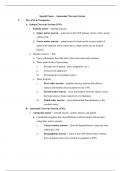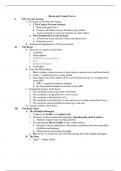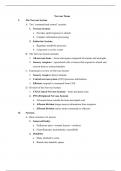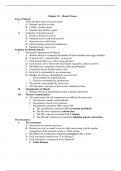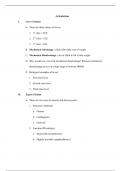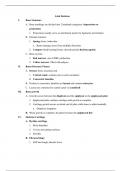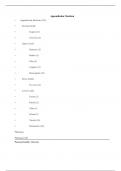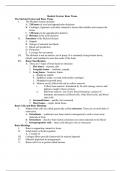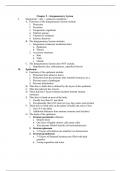Columbia International University
Latest uploads at Columbia International University. Looking for notes at Columbia International University? We have lots of notes, study guides and study notes available for your school.
-
409
- 0
-
30
All courses for Columbia International University
Latest notes & summaries Columbia International University
In this chapter of Human Anatomy and Physiology I, the notes cover the following details... 1. Somatic nervous system 2. Autonomic nervous system 3. Divisions of the ANS 4. Sympathetic activation 5. Parasympathetic activation My notes come strait from the powerpoint, book, and lecture. They are focused on organizing the information into an outline format so that it is easier to understand and creates a more efficient way of studying. I hope that this study tool helps you tremendously.
In this chapter of Human Anatomy and Physiology I, the notes cover the following details... 1. Anatomy of spinal cord 2. Difference between gray matter and white matter 3. Protective meninges of the spinal cord 4. Structure of spinal nerves and their relationship with the spinal cord My notes come strait from the powerpoint, book, and lecture. They are focused on organizing the information into an outline format so that it is easier to understand and creates a more efficient way of stud...
In this chapter of Human Anatomy and Physiology I, the notes cover the following details... 1. Six regions of the brain and their functions 2. Differences between gray matter and white matter in the CNS 3. Cranial nerves by name and number 4. Function of each cranial nerve 5. Cranial meninges and their functions My notes come strait from the powerpoint, book, and lecture. They are focused on organizing the information into an outline format so that it is easier to understand and creat...
In this chapter of Human Anatomy and Physiology I, the notes cover the following details... 1. Command and control systems of the body 2. Different types of neurons both anatomically and functionally 3. Structure and function of the synapse 4. Types of neuroglia found in the CNS and PNS and describe their functions 5. Electrochemical gradient and its use in maintaining the transmembrane potential 6. Differences between action potentials and graded potentials 7. Steps fo a propagating...
In this chapter of Human Anatomy and Physiology I, the notes cover the following details... 1. Three types of muscle tissue 2. Anatomy of skeletal muscle 3. Sliding filament theory 4. Steps of skeletal muscle contraction 5. Twitch, treppe, and tetanus 6. Motor units use within muscles 7. Differences between skeletal muscle, cardiac muscle, and smooth muscle My notes come strait from the powerpoint, book, and lecture. They are focused on organizing the information into an outline f...
In this chapter of Human Anatomy and Physiology I, the notes cover the following details... 1. First, second, and third class lever systems 2. Difference between mechanical advantage and disadvantage 3. Examples of first, second, and third class levers in the human body 4. Structural classes of joints 5. Functional classes of joints 6. Types of joints made by synovial joints 7. Structure of a synovial joint 8. Special joint movements My notes come strait from the powerpoint, book, ...
Listing of axial skeleton and number of each bone.
Listing of appendicular skeleton bones and their numbers.
In this chapter of Human Anatomy and Physiology I, the notes cover the following details... 1. Classes of bones 2. Histology of compact and spongy bone 3. Bone growth and response to external forces 4. Name of bone markings and their defining characteristics 5. Role of skeletal system in maintaining homeostasis My notes come strait from the powerpoint, book, and lecture. They are focused on organizing the information into an outline format so that it is easier to understand and creat...
In this chapter of Human Anatomy and Physiology I, the notes cover the following details... 1. Functions of the major organs of the integumentary system 2. Characteristics of the accessory structures of the integumentary system 3. Structure, function, and cells of the epidermis 4. Normal and pathological differences in skin color 5. Structure and function of the dermis 6. Characteristics of sensory receptors found in the integument 7. Characteristics of glands associated with the inte...

